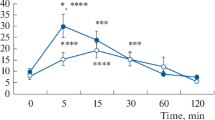Abstract
We studied the effects of models of imponderability (Antiorthostatic Hypodynamia, AH) and overload (AH + centrifugation) on discriminant learning in mice and the concentrations of monoamines and their metabolites in several brain structures. The experimental conditions accelerated the formation of the locomotor behavioral stereotype, which underlies discriminant food learning. This was accompanied by weaker food motivation of the experimental animals, as compared to the control animals. Presumably, this effect may be related to the so-called “sharpening of attention.” This occurs due to the suppression of the executive mechanisms of locomotor and exploratory activity, which decreases afferent generalization. Analysis of the concentrations of monoamines and their metabolites in the prefrontal cortex, hypothalamus, striatum, and cerebellum revealed considerable intensification of serotonin metabolism, in contrast to catecholamines. Behavioral results are discussed in the framework of the development of a negative emotional state related to the activity of the serotonergic system of the prefrontal cortex (“decision making” which is focused on escape from the negative state) and the realization of targeted behavior (“selection of action” as acquisition of rewards or food) by neuronal networks of the striatum and cerebellum. This response is possible with weak food motivation.
Similar content being viewed by others
References
Shtemberg, A.S., Aviakosmich. Ekol. Med., 1992, vol. 26, no. 4, pp. 64–67.
Shtemberg, A.S., Aviakosmich. Ekol. Med., 1997, vol. 31, no. 2, pp. 38–43.
Grigor’yan, G.A., Zh. Vyssh. Nervn. Deyat. im. I.P. Pavlova, 2005, vol. 55, no. 3, pp. 418–426.
Makarova, T.M., Varlinskaya, E.I., and Petrov, E.S., Zhurn. Vyssh. Nerv. Deyat. im. I.P. Pavlova, 1989, vol. 39, no. 3, pp. 513–519.
Poshivalov, V.P., Eksperimental’naya psikhofarmakologiya agressivnogo povedeniya (Experimental Psychopharmacology of Aggressive Behavior), Leningrad: Nauka, 1986.
Shtemberg, A.S., Zhurn. Vyssh. Nervn. Deyat. im. I.P. Pavlova, 1982, vol. 32, no. 3, pp. 463–471.
Shtemberg, A.S., Zhurn. Vyssh. Nervn. Deyat. im. I.P. Pavlova, 1987, vol. 37, no. 6, pp. 1090–1098.
Ushakov, I.B., Shtemberg, A.S., and Shafirkin, A.V., Reaktivnost’ i rezistentnost’ organizma mlekopitayushchikh (Reactivity and Resistance of Mammalian Body), Moscow: Nauka, 2007.
Gorbunova, A.V., Kudrin, V.S., and Klodt, P.M., Neirokhimiya, 2006, vol. 23, no. 2, pp. 156–158.
Bazyan, A.S. and Grigor’yan, G.A., Usp. Fiziol. Nauk, 2006, vol. 37, no. 1, pp. 68–83.
Bazyan, A.S., Grigor’yan, G.A., and Ioffe, M.E., Usp. Fiziol. Nauk, 2011, vol. 42, no. 3, pp. 65–80.
Simonov, P.V., Izbrannye trudy (Selected Studies), Moscow: Nauka, 2004, vol. 1.
Frank, M.J., Scheres, A., and Sherman, S.J., Phil. Trans. R. Soc., vol. 362, pp. 1641–1654.
de Visser, L. and Baars, A.M., Van’ T Klooster J., and Van Den Bos R, Frontier. Neurosci., 2011, vol. 5, pp. 1–8.
Redgrave, P., Prescott, T.J., and Garney, K., Neuroscience, 1999, vol. 89, no. 4, pp. 1009–1023.
Stafford, T. and Gurney, K.N., Philos. Trans. R. Soc. Lond. B. Biol. Sci., vol. 362, no. 1485, pp. 1671–1684.
Soubrie, P., Reisine, T.D., and Glowinski, J., Neuroscience, 1984, vol. 13, pp. 605–625.
Xue, B. and Kahn, B.B., J. Physiol., 2006, vol. 574, pp. 73–83.
Barson, J.R., Morganstern, I., and Leibowitz, S.F., Physiol. Behav., 2011, vol. 104, no. 1, pp. 128–137.
Shoji, M. and Yasujima, M., Rinsho Byori, 1999, vol. 47, no. 12, pp. 1121–1127.
Morrow, A.L., Porcu, P., Boyd, K.N., and Grant, K.A., Dialogues Clin. Neurosci., 2006, vol. 8, no. 4, pp. 463–477.
Aston-Jones, G., Smith, R.J., Moorman, D.E., and Richardson, K.A., Neuropharmacol., 2009, vol. 56, pp. 112–121.
Aston-Jones, G., Smith, R.J., Sartor, G.C., Moorman, D.E., Massi, L., Tahsili-Fahadan, P., and Richardson, K.A., Brain Res., 2010, vol. 1314, no. 1, pp. 74–90.
Diener, H.C., Dichgans, J., Guschlbauer, B., Bacher, M., Rapp, H., and Langenbach, P., Rev. Neurol. (Paris), 1990, vol. 146, pp. 555–563.
Diedrichsen, J., Verstynen, T., Lehman, S.L., and Ivry, R.B., J. Neurophysiol., 2005, vol. 93, pp. 801–812.
Arshavskii, Yu.I., Gel’fand, I.M., and Orlovskii, G.N., Mozzhechok i upravlenie ritmicheskimi dvizheniyami (Cerebellum and Control of Rhythmic Movements), Moscow: Nauka, 1984.
Author information
Authors and Affiliations
Corresponding author
Additional information
Original Russian Text © A.S. Shtemberg, V.S. Kudrin, P.M. Klodt, V.B. Narkevich, A.S. Bazyan, 2012, published in Neirokhimiya, 2012, Vol. 29, No. 4, pp. 318–326.
Rights and permissions
About this article
Cite this article
Shtemberg, A.S., Kudrin, V.S., Klodt, P.M. et al. The effects of antiorthostatic hypodynamia and overload on discriminant learning and monoamine exchange in the brain structures of mice. Neurochem. J. 6, 291–298 (2012). https://doi.org/10.1134/S1819712412030130
Received:
Published:
Issue Date:
DOI: https://doi.org/10.1134/S1819712412030130



